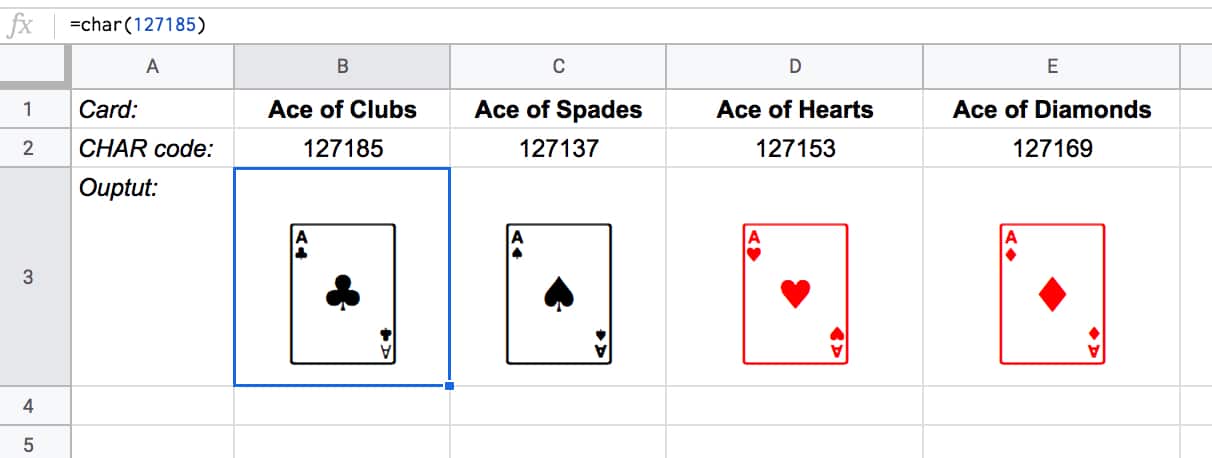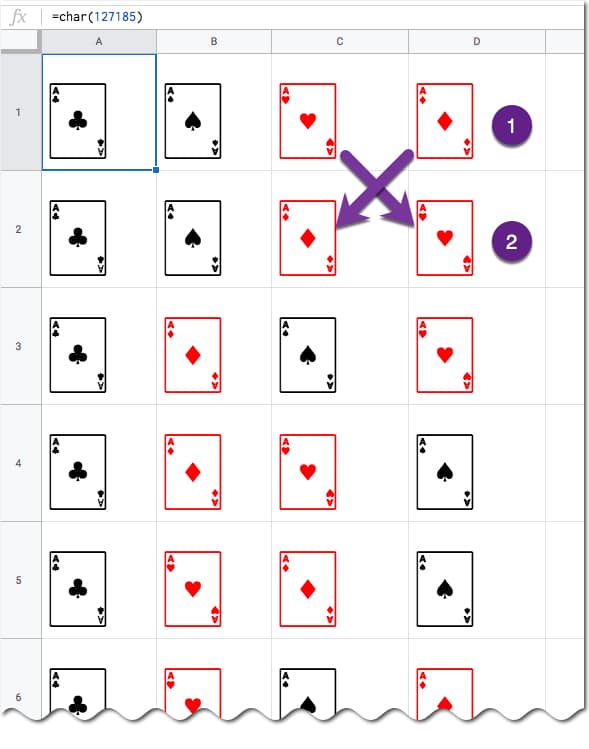Let’s start with a mind-blowing fact, and then use the FACT function in Google Sheets to explain it.
Pick up a standard 52 card deck and give it a good shuffle.
The order of cards in a shuffled deck will be unique.
One that has likely never been seen before in the history of the universe and will likely never be seen again.
I’ll let that sink in.
Isn’t that mind-blowing?
Especially when you picture all the crazy casinos in Las Vegas.
Let’s understand why, and in the process learn about the FACT function and basic combinatorics (the study of counting in mathematics).
Four Card Deck
To keep things simple, suppose you only have 4 cards in your deck, the four aces.
You can create this deck in Google Sheets with the CHAR function:
The formulas to create these four cards are:
Ace of Clubs:
=CHAR(127185)Ace of Spades:
=CHAR(127137)Ace of Hearts:
=CHAR(127153)Ace of Diamonds:
=CHAR(127169)Let’s see how many different combinations exist with just these four cards.
Pick one of them to start. You have a choice of four cards at this stage.
Once you’ve chosen the first one, you have three cards left, so there are 3 possible options for the second card choice.
When you’ve picked that second card, you have two cards left. So you have a choice of two for the third card.
The final card is the last remaining one.
So you have 4 choices * 3 choices * 2 choices * 1 choice = 4 * 3 * 2 * 1 = 24
There are 24 permutations (variations) with just 4 cards!
Visually, we can show this in our Google Sheet by displaying all the different combinations with the card images from above:
(I’ve just shown the first 6 rows for brevity.)
You can see for example, when moving from row 1 to row 2, we swapped the position of the two red suits: the Ace of Hearts and the Ace of Diamonds.
Five Card Deck
This time there are 5 choices for the first card, then 4, then 3, then 2, and finally 1.
So the number of permutations is 5 * 4 * 3 * 2 * 1 = 120
Already a lot more! I have not drawn this out in a Google Sheet and leave that as an optional exercise for you if you wish.
The FACT function
The FACT function in Google Sheets (see documentation) is a math function that returns the factorial of a given number. The factorial is the product of that number with all the numbers lower than it down to 1.
In other words, exactly what we’ve done above in the above calculations.
Four:
The 4 card deck formula is:
which gives an answer of 24 permutations.
Five:
The 5 card deck formula is:
which gives an answer of 120 permutations.
Six:
A 6 card deck is:
which gives an answer of 720 permutations.
Twelve:
A 12 card deck has 479,001,600 different ways of being shuffled:
(You’re more likely to win the Powerball lottery at 1 in 292 million odds than to get two matching shuffled decks of cards, even with just 12 cards!)
Fifty Two:
Keep going up to a full deck of 52 cards with the formula and it’s a staggeringly large number.
Type it into Google Sheets and you’ll see an answer of 8.07E+67, which is 8 followed by 67 zeros!
(This number notation is called scientific notation, where huge numbers are rounded to the first few digits multiplied by a 10 to the power of some number, 67 in this case.)
This answer is more than the number of stars in the universe (about 10 followed by 21 zeros).
Put another way if all 6 billion humans on earth began shuffling cards at 1 deck per minute every day of the year for millions of years, we still wouldn’t even be close to finding all possible combinations.


Really mind blowing. Not only the “FACT” but the way you explained.
Thank you
Thanks, it is crazy, isn’t it? Doesn’t feel right 😉
Love it Ben! I might send this on to the math and science teachers at my school.
Thanks for an amazing post!
Thanks, James! Yeah, it really makes you pause for thought…
“Put another way if all 6 billion humans on earth began shuffling cards at 1 deck per minute every day of the year for millions of years, we still wouldn’t even be close to finding all possible combinations.”
So how long would it take?
Let’s disregard that the population is a little bit of an underestimate because (a) it doesn’t make a huge difference and (b) over the millions of years, the human population will be fluctuating anyways.
6 billion humans, a new permutation every minute of every day. Each day, that is
6,000,000,000 × 60 (mins per hour) × 24 (hours in a day) = 8,640,000,000,000 permutations each day.
Over the course of a year, that would be
8,640,000,000,000 × 365(ish) = 3,153,600,000,000,000
That’s a little over 3 quadrillion (or 3 million billion if the numbers are getting a bit big at this point). That is a 3 with 15 trailing zeroes.
As Ben stated, FACT(52) is an 8 with 67 zeroes. So we just need to divide FACT(52) by 3 quadrillion and we get a staggering
26 million billion billion billion billion billion years or 26 sexdecillion years.
By this time, there won’t be any humans left to continue shuffling cards. There won’t have been any life in the universe at this point for a very a long time. This is in the black hole era of the universe, where all that’s left is very sparse dust and black holes evaporating. There are no more stars. There is no more light.
It might sound like a depressing future for the universe, but it’s better to see it as a peaceful ending. And even though no life will exist then, we can still give value to our own lives here and now and be wise when playing the cards we’re dealt.
Love it! Thanks for expanding on that point and showing us just how crazy large FACT(52) is! Cheers.
MIND. BLOWN.
Thanks for the fun post 🙂
You’re welcome! It feels so counter-intuitive… 😉
Hello, Je n’ai trouvé que 20 choix possibles avec 4 cartes ??
Merci, j’ai appris aujourd’hui ‘FACT’ une fonction vraiment TRÈS utile.
What should happen, then, when you type =fact(52) is that Google Sheets should explode.